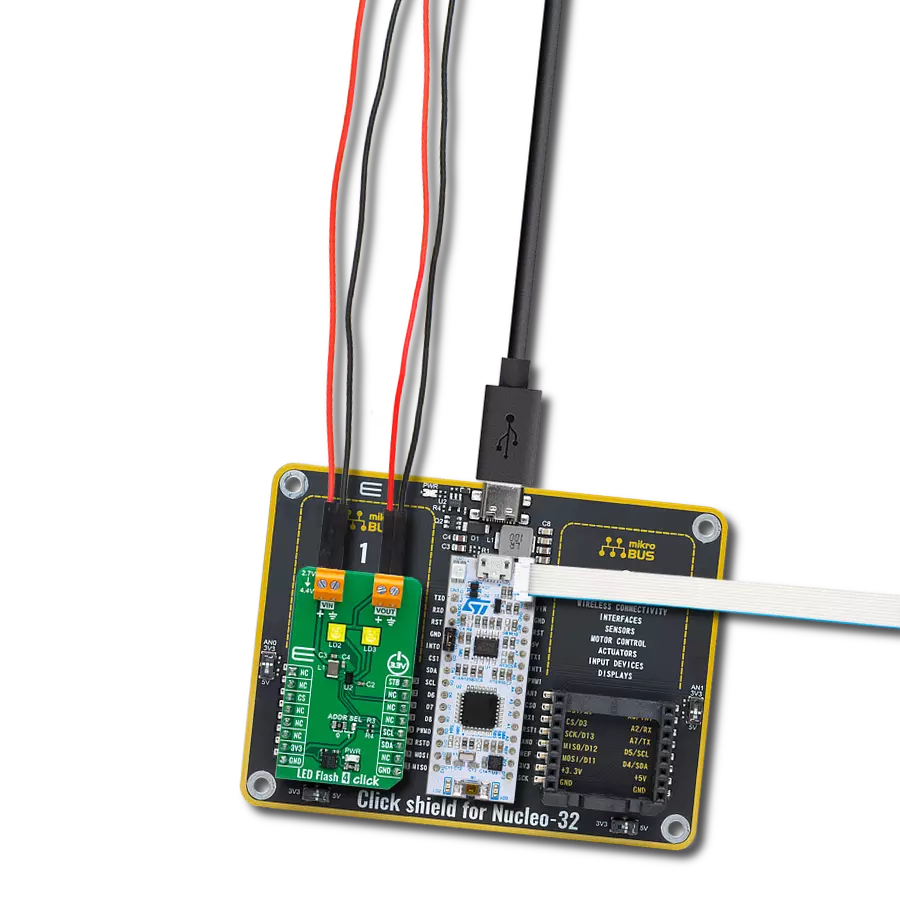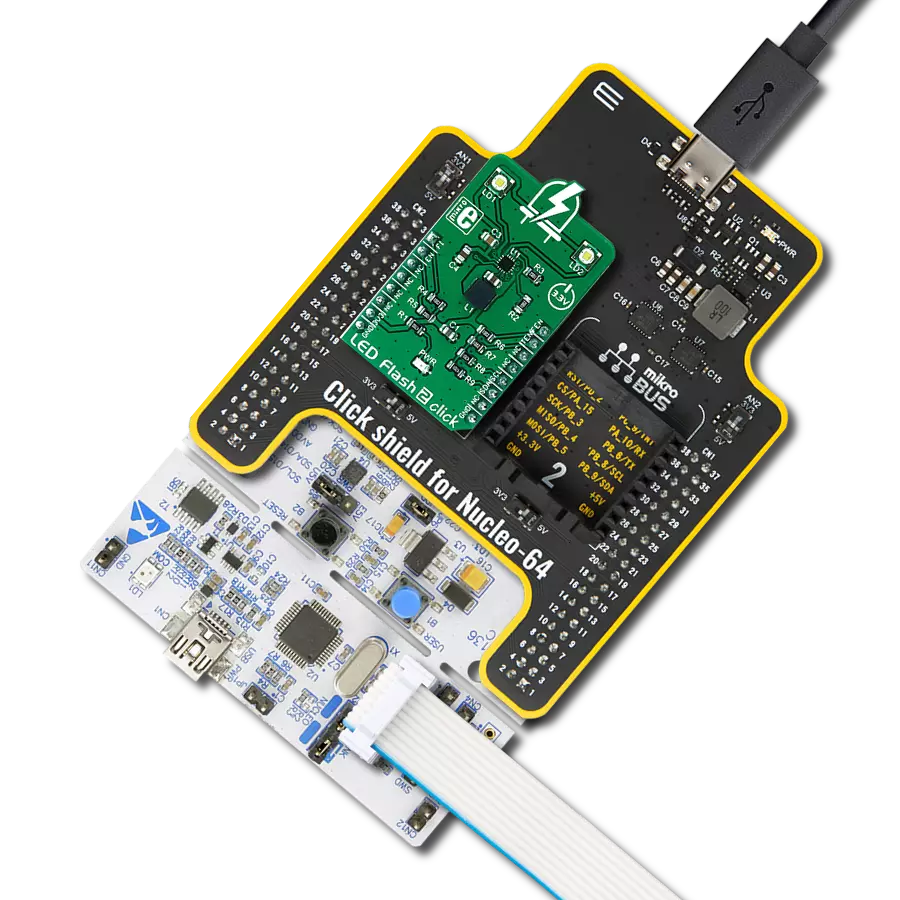Our full-color RGB 7-segment digit display is engineered to provide a vibrant and dynamic visual experience, enabling you to express your creativity and showcase information with dazzling, customizable colors
A
A
Hardware Overview
How does it work?
7-SEG RGB Click is based on the 160100-71, a full-color single 7-segment digit display from Elektor. The click is designed to run on either 3.3V or 5V power supply. It communicates with the target microcontroller over the CS, and PWM pin on the mikroBUS™ line. The click can be connected in a chain, in order to display a larger number of characters. Unlike with conventional 7
segment displays, you will be able to use multiple colors on the display. Each segment has R, G, B LEDs that can be adjusted in 255 steps and therefore 16,581,375 color combinations are available for each segment of the digit on the display. Also, the ability to control the brightness of all the LED's is driven at 255 steps. It should be noted that the brightness values above 80 should
rarely be used. This Click board™ can operate with either 3.3V or 5V logic voltage levels selected via the LOGIC SEL jumper. This way, both 3.3V and 5V capable MCUs can use the communication lines properly. Also, this Click board™ comes equipped with a library containing easy-to-use functions and an example code that can be used as a reference for further development.
Features overview
Development board
Curiosity PIC32 MZ EF development board is a fully integrated 32-bit development platform featuring the high-performance PIC32MZ EF Series (PIC32MZ2048EFM) that has a 2MB Flash, 512KB RAM, integrated FPU, Crypto accelerator, and excellent connectivity options. It includes an integrated programmer and debugger, requiring no additional hardware. Users can expand
functionality through MIKROE mikroBUS™ Click™ adapter boards, add Ethernet connectivity with the Microchip PHY daughter board, add WiFi connectivity capability using the Microchip expansions boards, and add audio input and output capability with Microchip audio daughter boards. These boards are fully integrated into PIC32’s powerful software framework, MPLAB Harmony,
which provides a flexible and modular interface to application development a rich set of inter-operable software stacks (TCP-IP, USB), and easy-to-use features. The Curiosity PIC32 MZ EF development board offers expansion capabilities making it an excellent choice for a rapid prototyping board in Connectivity, IOT, and general-purpose applications.
Microcontroller Overview
MCU Card / MCU

Architecture
PIC32
MCU Memory (KB)
2048
Silicon Vendor
Microchip
Pin count
100
RAM (Bytes)
524288
Used MCU Pins
mikroBUS™ mapper
Take a closer look
Click board™ Schematic

Step by step
Project assembly
Track your results in real time
Application Output
1. Application Output - In Debug mode, the 'Application Output' window enables real-time data monitoring, offering direct insight into execution results. Ensure proper data display by configuring the environment correctly using the provided tutorial.

2. UART Terminal - Use the UART Terminal to monitor data transmission via a USB to UART converter, allowing direct communication between the Click board™ and your development system. Configure the baud rate and other serial settings according to your project's requirements to ensure proper functionality. For step-by-step setup instructions, refer to the provided tutorial.

3. Plot Output - The Plot feature offers a powerful way to visualize real-time sensor data, enabling trend analysis, debugging, and comparison of multiple data points. To set it up correctly, follow the provided tutorial, which includes a step-by-step example of using the Plot feature to display Click board™ readings. To use the Plot feature in your code, use the function: plot(*insert_graph_name*, variable_name);. This is a general format, and it is up to the user to replace 'insert_graph_name' with the actual graph name and 'variable_name' with the parameter to be displayed.

Software Support
Library Description
This library contains API for 7-SEG RGB Click driver.
Key functions:
c7segrgb_set_num- The function sets character and its colorc7segrgb_set_seven_seg- The function sets the state and color of every segment from click board object segment array data
Open Source
Code example
The complete application code and a ready-to-use project are available through the NECTO Studio Package Manager for direct installation in the NECTO Studio. The application code can also be found on the MIKROE GitHub account.
/*!
* \file
* \brief 7-SEG RGB Click example
*
* # Description
* This Click shows all ten digits on a full-color single 7 segment digit display.
* Each segment has R, G, B LEDs that can be adjusted in 255 steps and
* the ability to control the brightness of all the LED.
*
* The demo application is composed of two sections :
*
* ## Application Init
* Initialization driver enables - GPIO.
*
* ## Application Task
* This is an example which demonstrates the use of 7-SEG RGB Click board.
* This simple example shows all ten digits in different colors on 7-SEG RGB Click.
*
* @note
* Make sure the logic delays are defined for your system in the c7segrgb_delays.h file.
*
* <pre>
* Additional Functions :
* void logic_one ( ) - Generic logic one function.
* void logic_zero ( ) - Generic logic zero function.
* </pre>
*
* - segments layout
* _0_
* 5| |1
* |_6_|
* 4| |2
* |_3_|.7
*
* \author MikroE Team
*
*/
// ------------------------------------------------------------------- INCLUDES
#include "board.h"
#include "c7segrgb.h"
#include "c7segrgb_delays.h"
// ------------------------------------------------------------------ VARIABLES
static c7segrgb_t c7segrgb;
static uint8_t CHARACTER_TABLE[ 10 ] =
{
0x3F, // '0'
0x06, // '1' _a_
0x5B, // '2' f| |b
0x4F, // '3' |_g_|
0x66, // '4' e| |c
0x6D, // '5' |_d_|.dp
0x7D, // '6'
0x07, // '7'
0x7F, // '8'
0x6F // '9'
};
static c7segrgb_segment_t segments_data[ 8 ] =
{
{ true, 40, 0, 0 },
{ true, 0, 40, 0 },
{ true, 0, 0, 40 },
{ true, 10, 40, 40 },
{ true, 40, 10, 40 },
{ true, 40, 40, 10 },
{ true, 10, 20, 30 },
{ true, 30, 20, 10 }
};
// ------------------------------------------------------- ADDITIONAL FUNCTIONS
void logic_one ( void )
{
hal_ll_gpio_set_pin_output( &c7segrgb.pwm.pin );
DELAY_T1H;
hal_ll_gpio_clear_pin_output( &c7segrgb.pwm.pin );
DELAY_T1L;
}
void logic_zero ( void )
{
hal_ll_gpio_set_pin_output( &c7segrgb.pwm.pin );
DELAY_TOH;
hal_ll_gpio_clear_pin_output( &c7segrgb.pwm.pin );
DELAY_TOL;
}
// ------------------------------------------------------ APPLICATION FUNCTIONS
void application_init ( void )
{
c7segrgb_cfg_t cfg;
// Click initialization.
c7segrgb_cfg_setup( &cfg );
cfg.logic_one = &logic_one;
cfg.logic_zero = &logic_zero;
C7SEGRGB_MAP_MIKROBUS( cfg, MIKROBUS_1 );
c7segrgb_init( &c7segrgb, &cfg );
for ( uint8_t cnt = 0; cnt < 8; cnt++ )
{
c7segrgb.segments[ cnt ] = segments_data[ cnt ];
}
c7segrgb_set_seven_seg( &c7segrgb );
Delay_ms ( 1000 );
Delay_ms ( 1000 );
Delay_ms ( 1000 );
}
void application_task ( void )
{
for ( uint8_t cnt_i = 0; cnt_i < 10; cnt_i++ )
{
for ( uint8_t cnt_j = 10; cnt_j > 0; cnt_j-- )
{
c7segrgb_set_num( &c7segrgb, CHARACTER_TABLE[ cnt_i ], 4 * cnt_i, 4 * cnt_j, cnt_i * cnt_j );
Delay_ms ( 100 );
}
}
c7segrgb_set_num( &c7segrgb, C7SEGRGB_POINT, 10, 10, 10 );
Delay_ms ( 1000 );
c7segrgb_set_num( &c7segrgb, C7SEGRGB_ZERO, 40, 40, 40 );
Delay_ms ( 1000 );
c7segrgb_set_num( &c7segrgb, C7SEGRGB_ONE, 40, 0, 0 );
Delay_ms ( 1000 );
c7segrgb_set_num( &c7segrgb, C7SEGRGB_TWO, 0, 40, 0 );
Delay_ms ( 1000 );
c7segrgb_set_num( &c7segrgb, C7SEGRGB_THREE, 0, 0, 40 );
Delay_ms ( 1000 );
c7segrgb_set_num( &c7segrgb, C7SEGRGB_FOUR, 40, 0, 40 );
Delay_ms ( 1000 );
c7segrgb_set_num( &c7segrgb, C7SEGRGB_FIVE, 0, 40, 40 );
Delay_ms ( 1000 );
c7segrgb_set_num( &c7segrgb, C7SEGRGB_SIX, 40, 40, 0 );
Delay_ms ( 1000 );
c7segrgb_set_num( &c7segrgb, C7SEGRGB_SEVEN, 20, 30, 40 );
Delay_ms ( 1000 );
c7segrgb_set_num( &c7segrgb, C7SEGRGB_EIGHT, 40, 15, 31 );
Delay_ms ( 1000 );
c7segrgb_set_num( &c7segrgb, C7SEGRGB_NINE, 20, 10, 30 );
Delay_ms ( 1000 );
}
int main ( void )
{
/* Do not remove this line or clock might not be set correctly. */
#ifdef PREINIT_SUPPORTED
preinit();
#endif
application_init( );
for ( ; ; )
{
application_task( );
}
return 0;
}
// ------------------------------------------------------------------------ END
Additional Support
Resources
Category:LED Segment

































